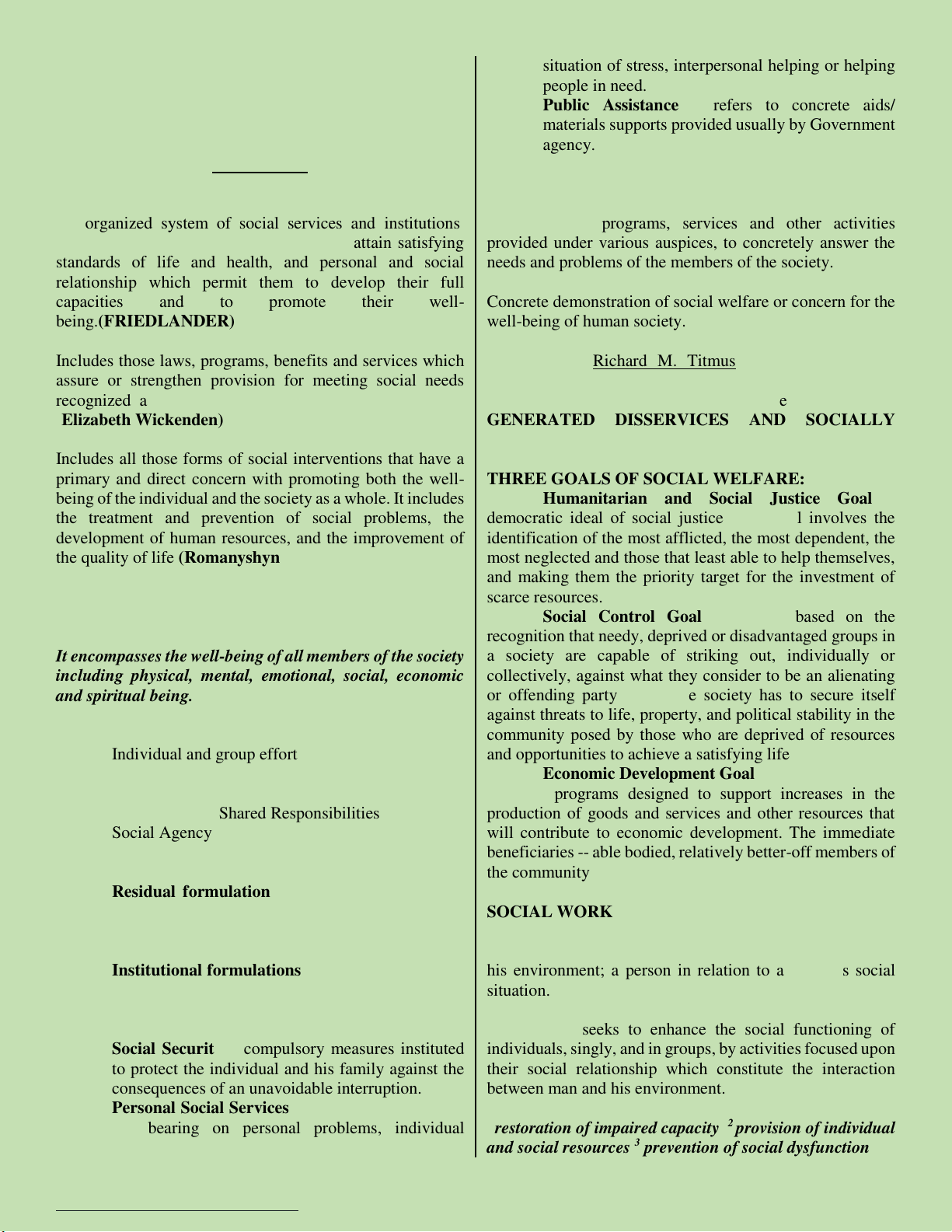
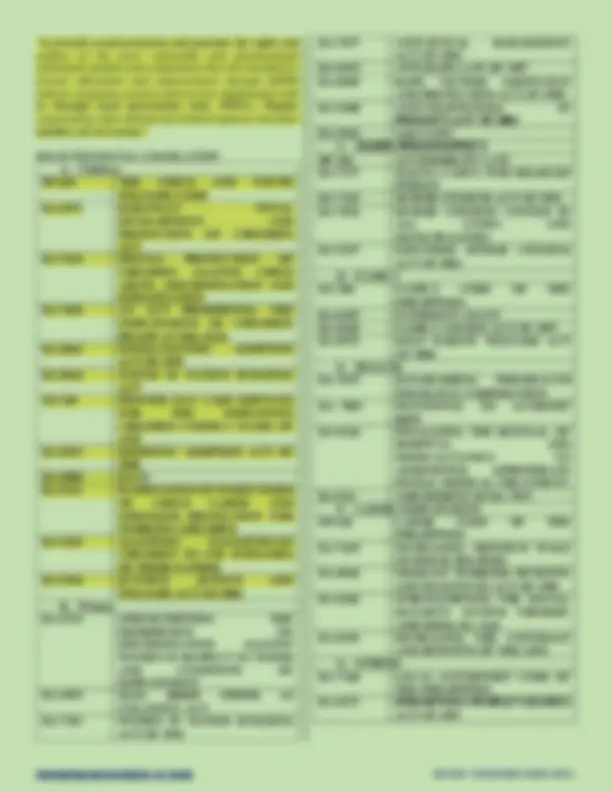
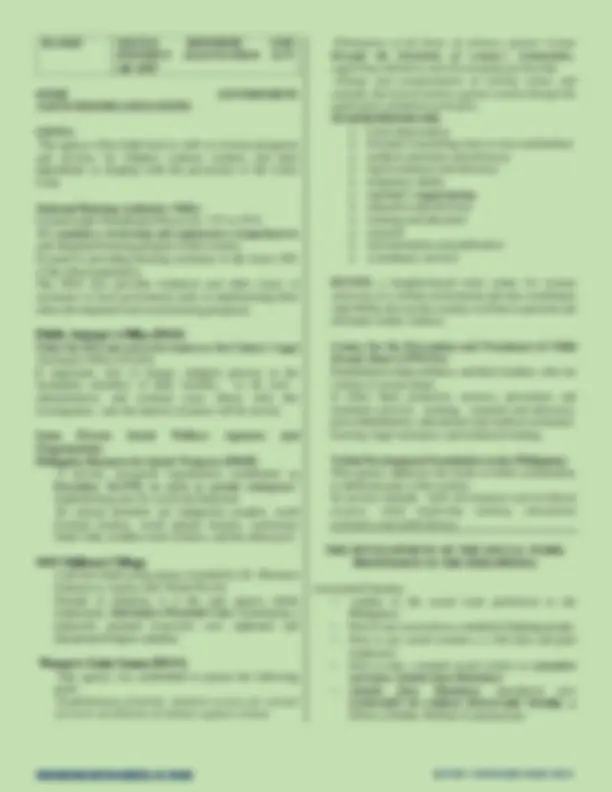
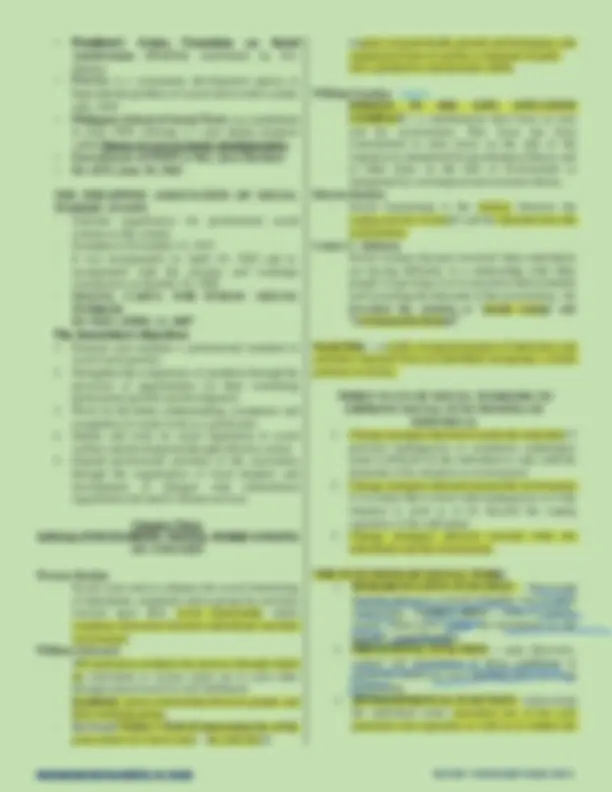
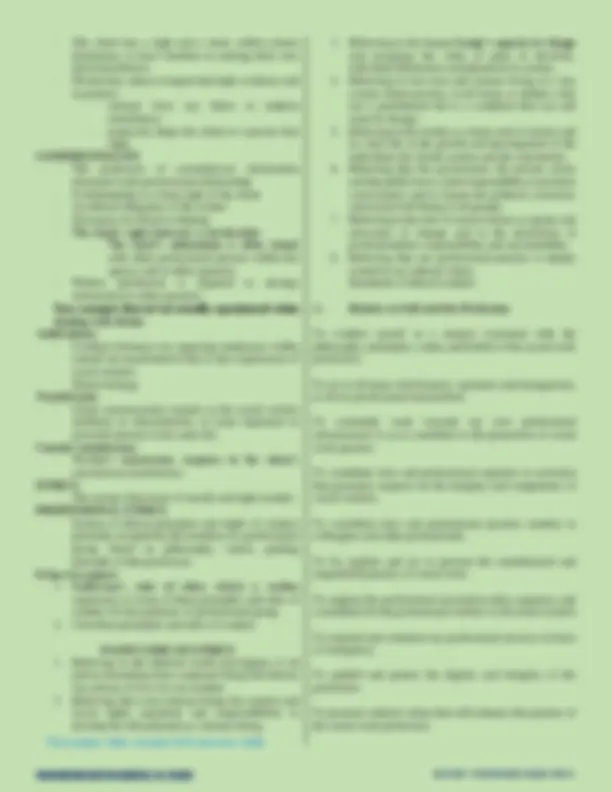
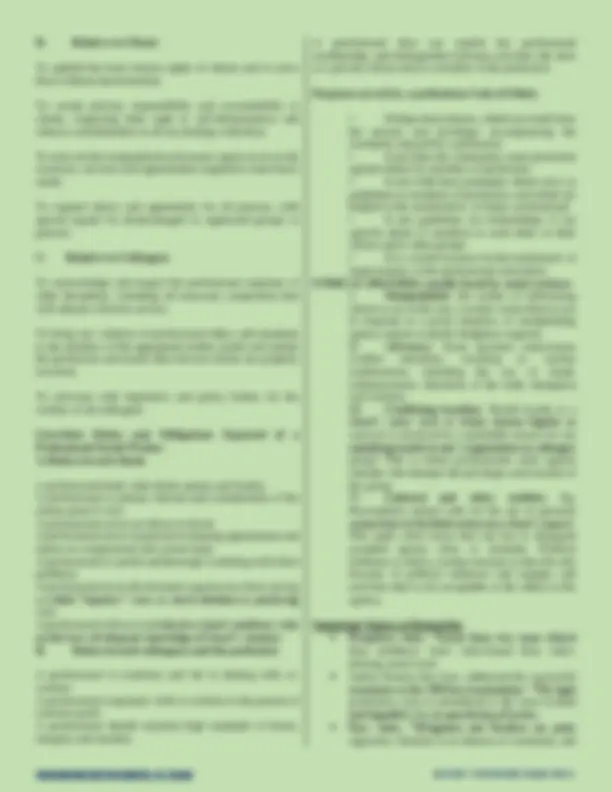
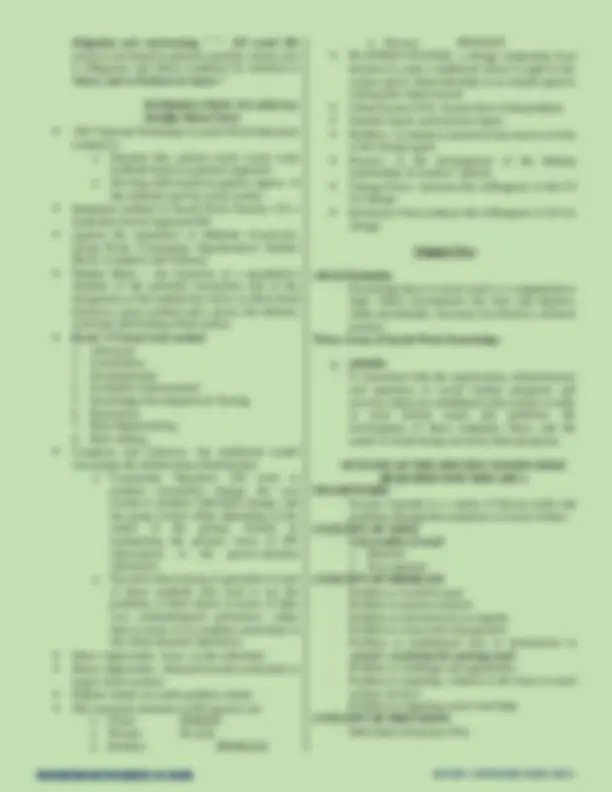
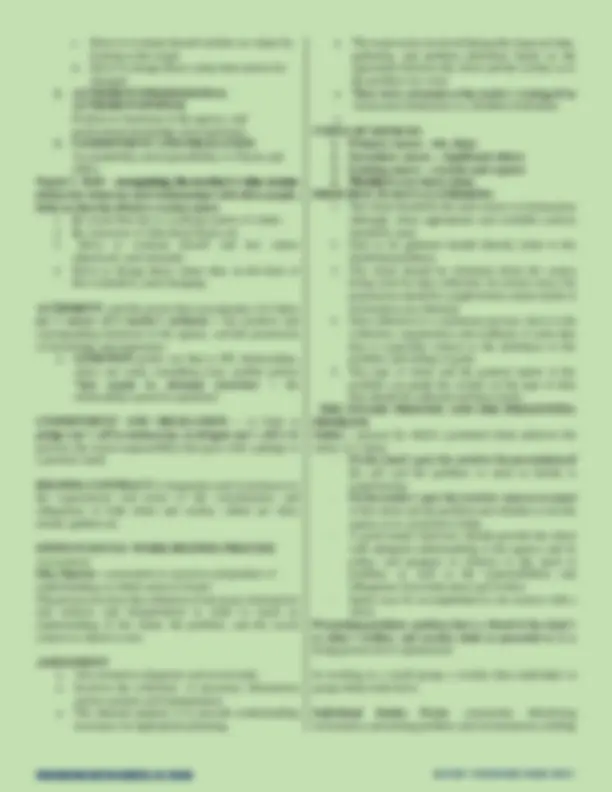
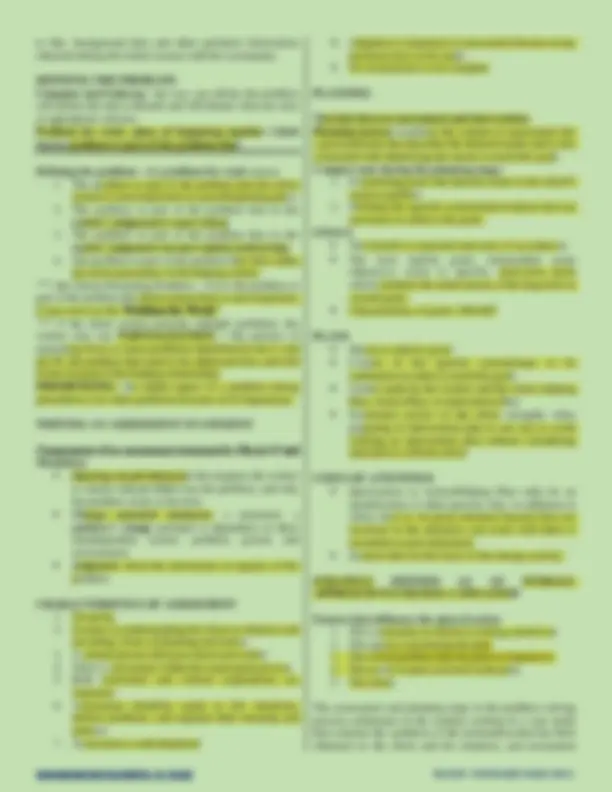
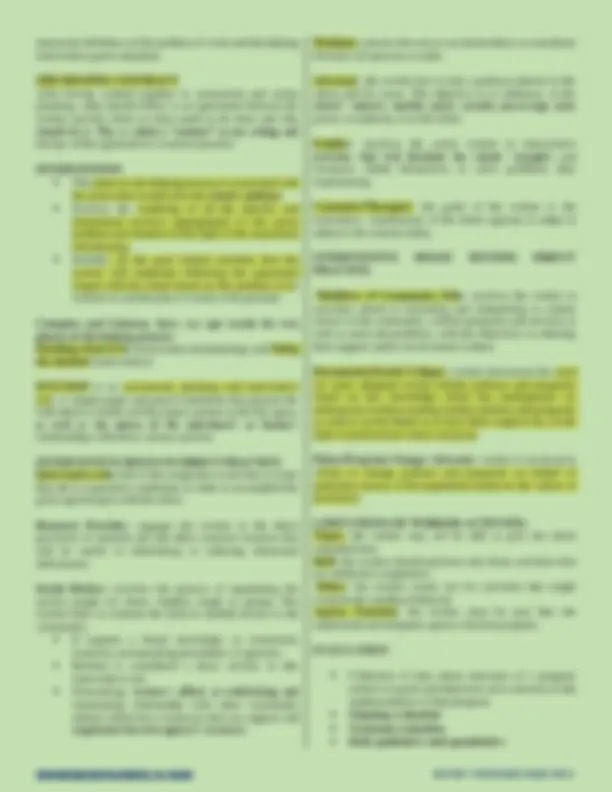
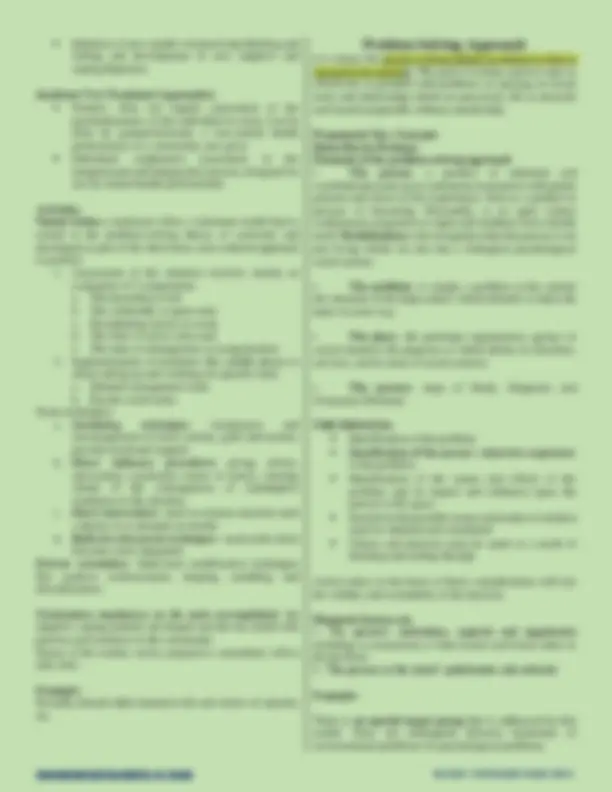
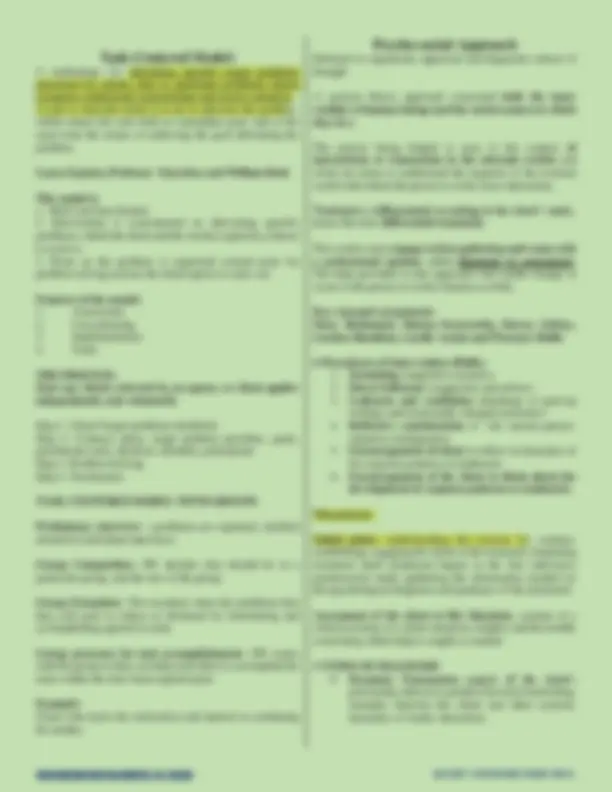
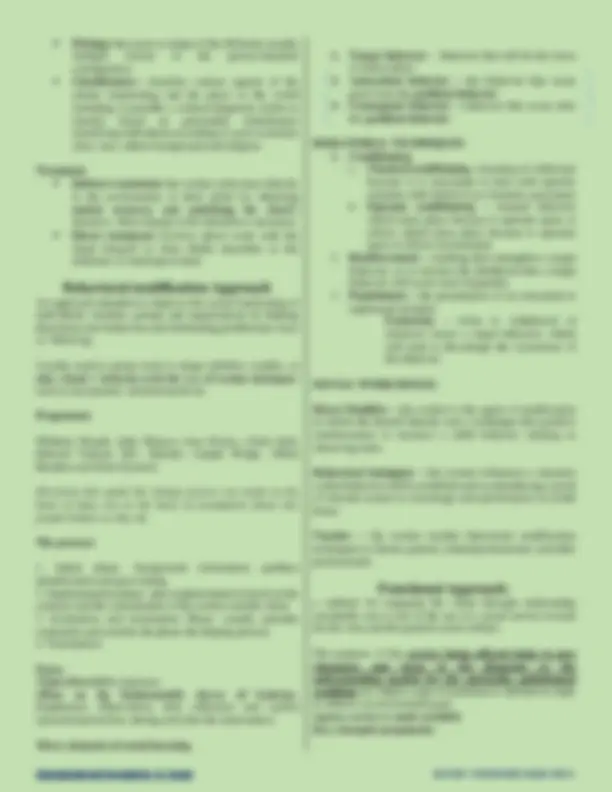
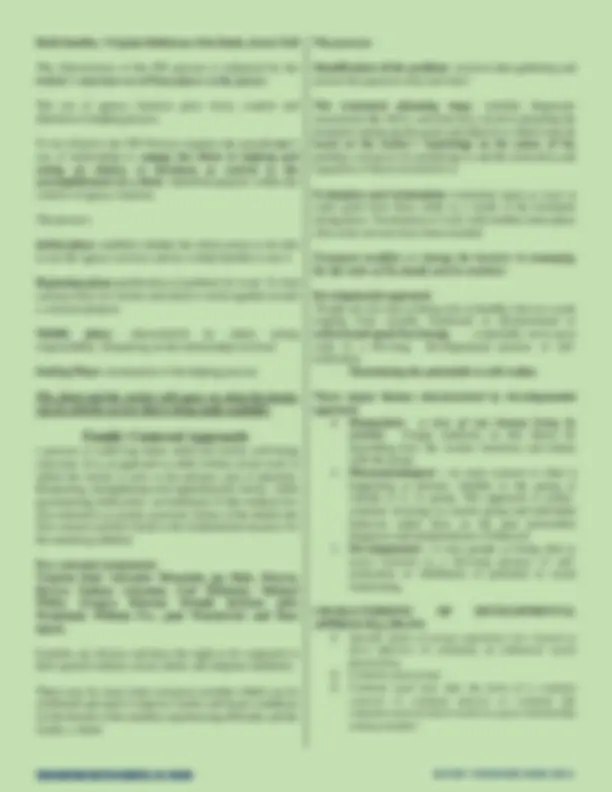
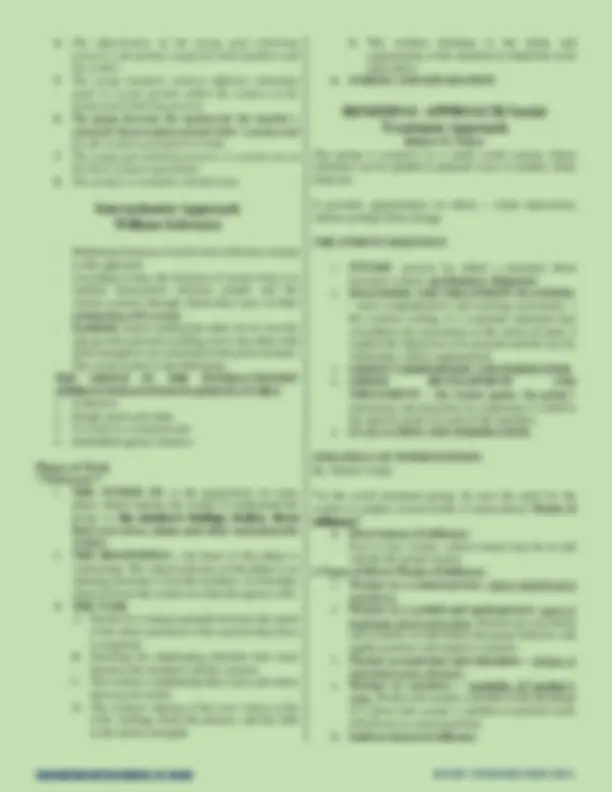
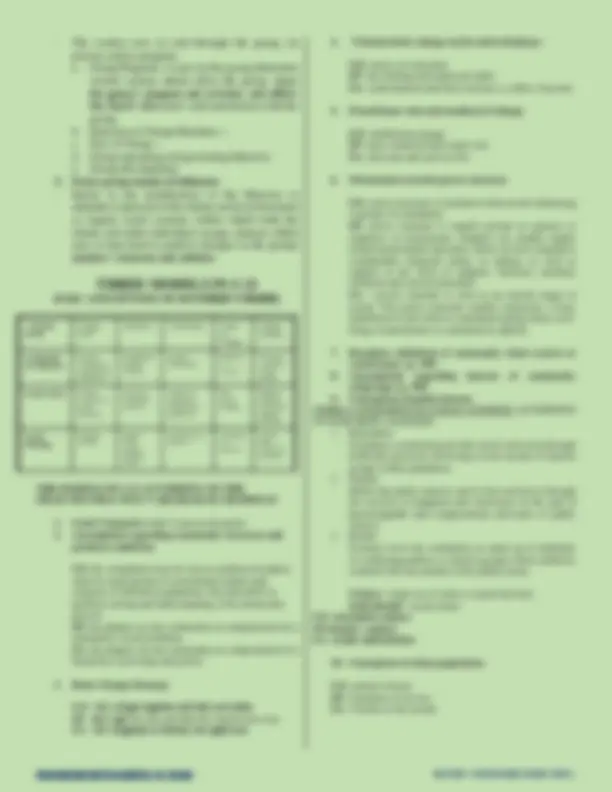
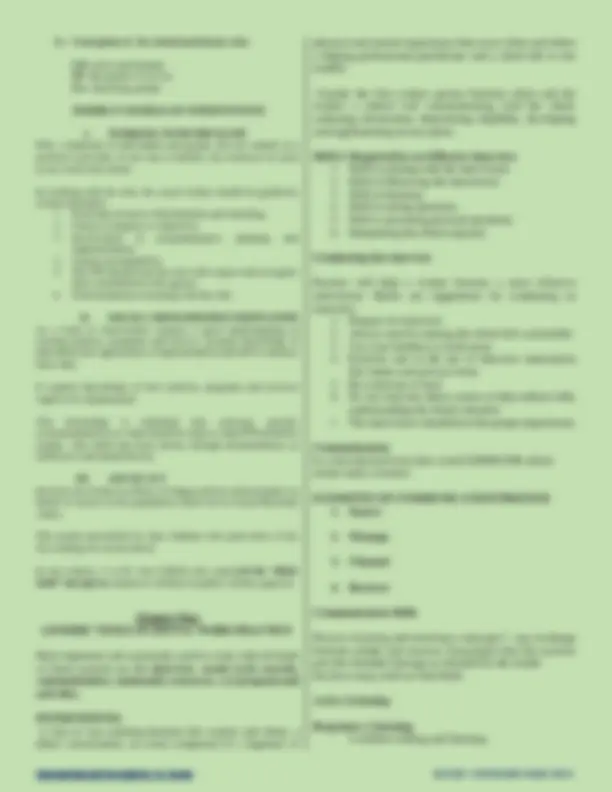
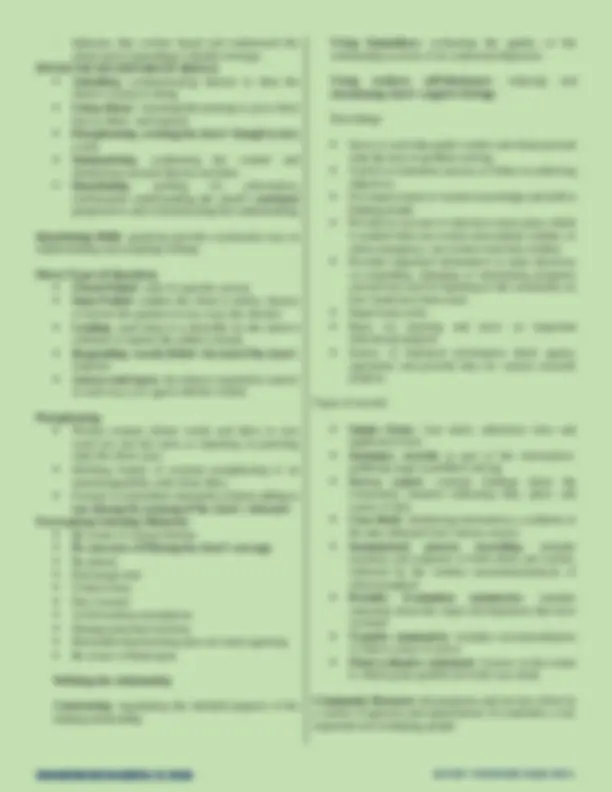
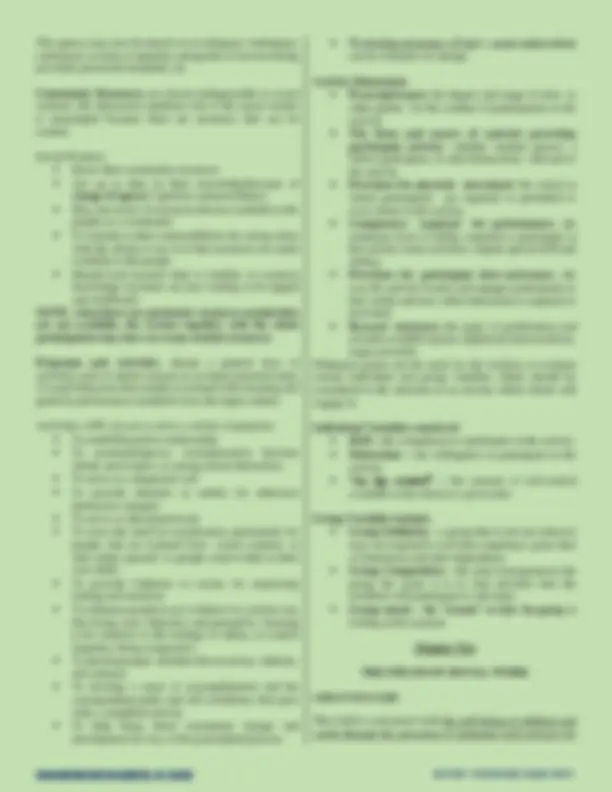
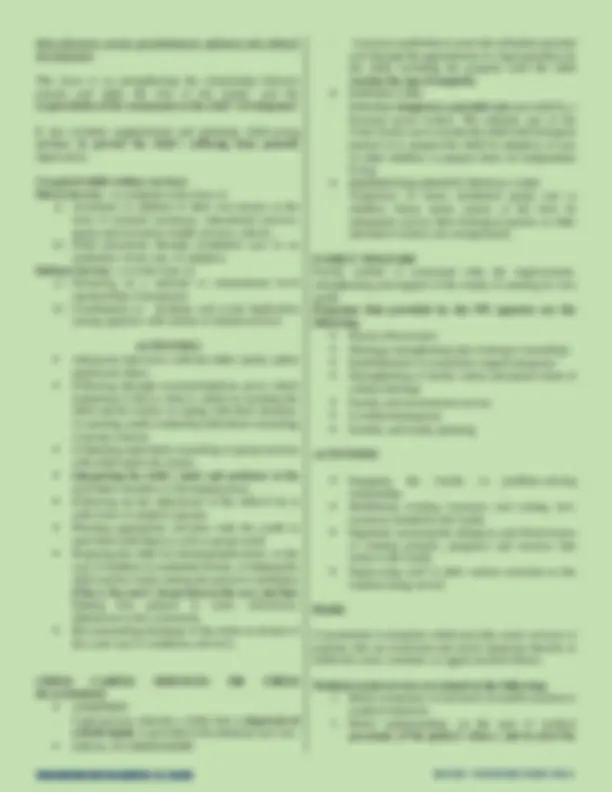
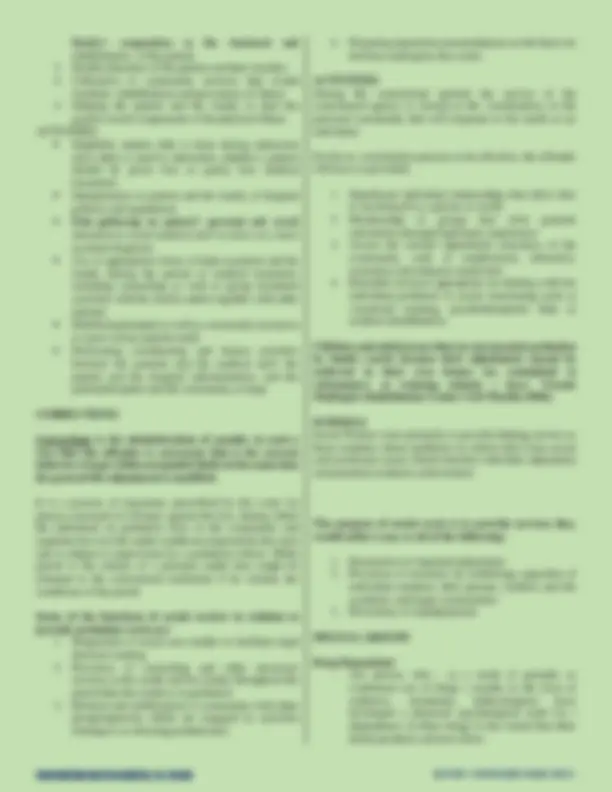
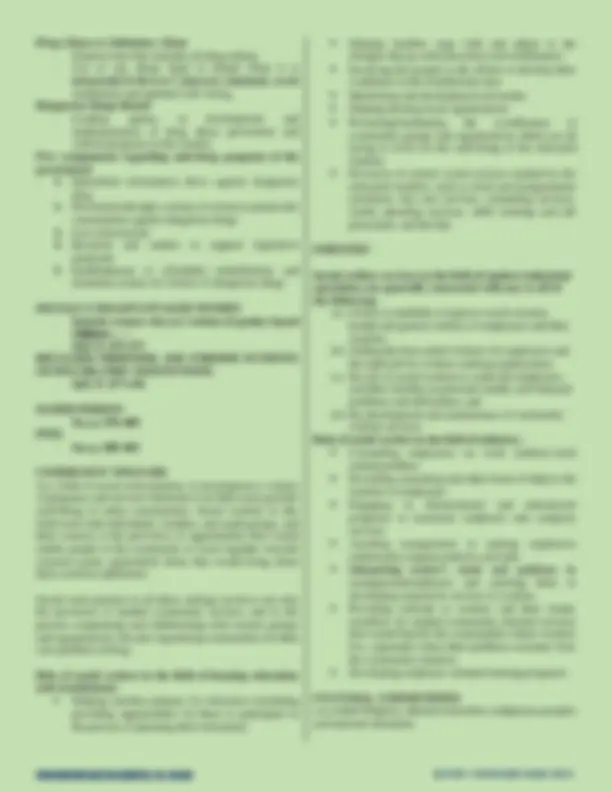
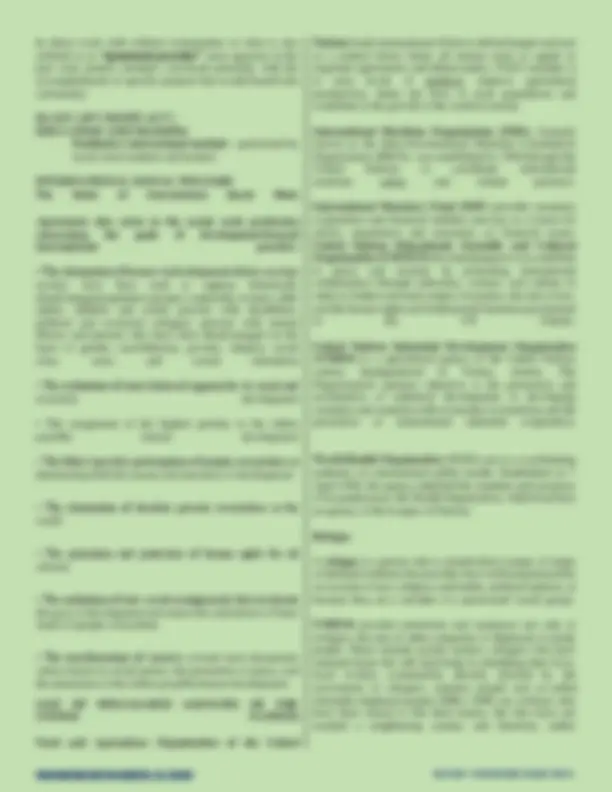
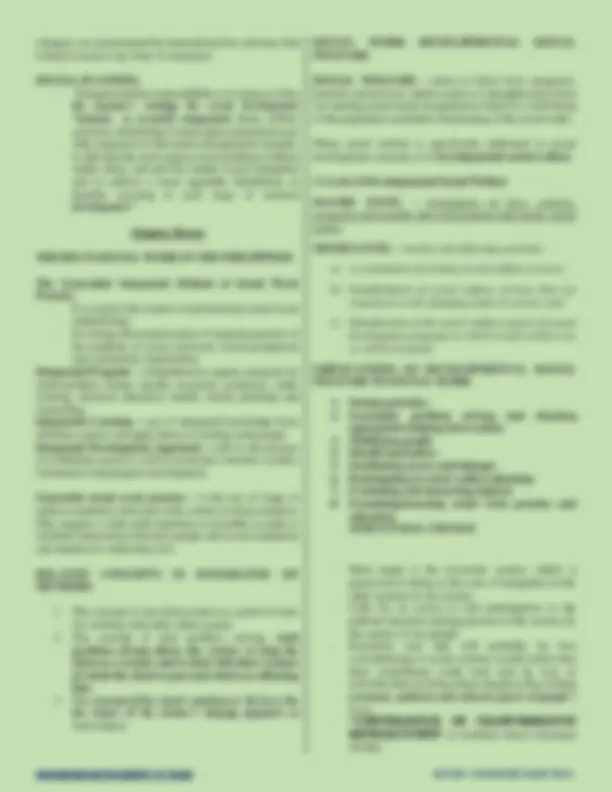
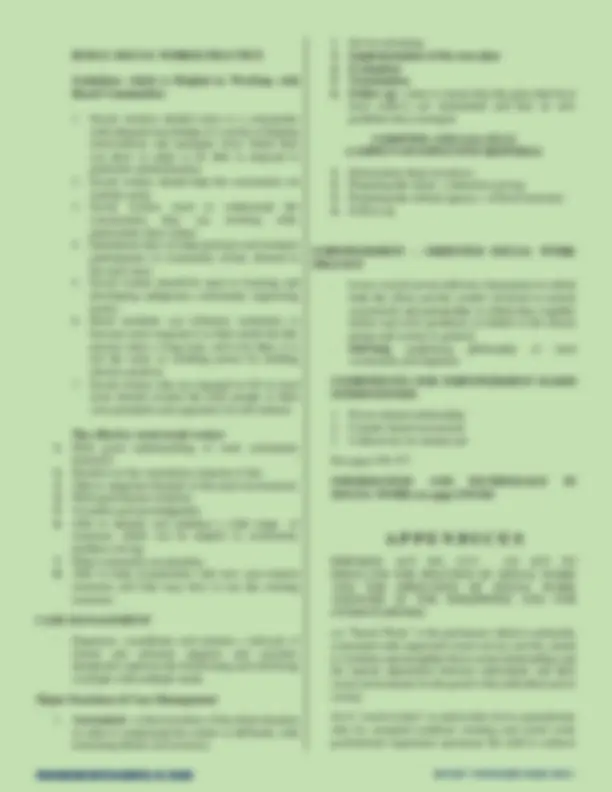
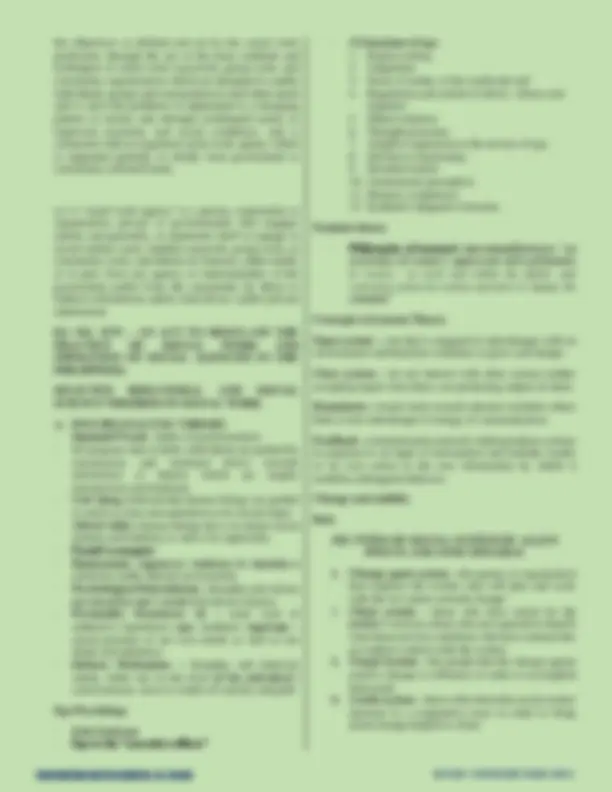
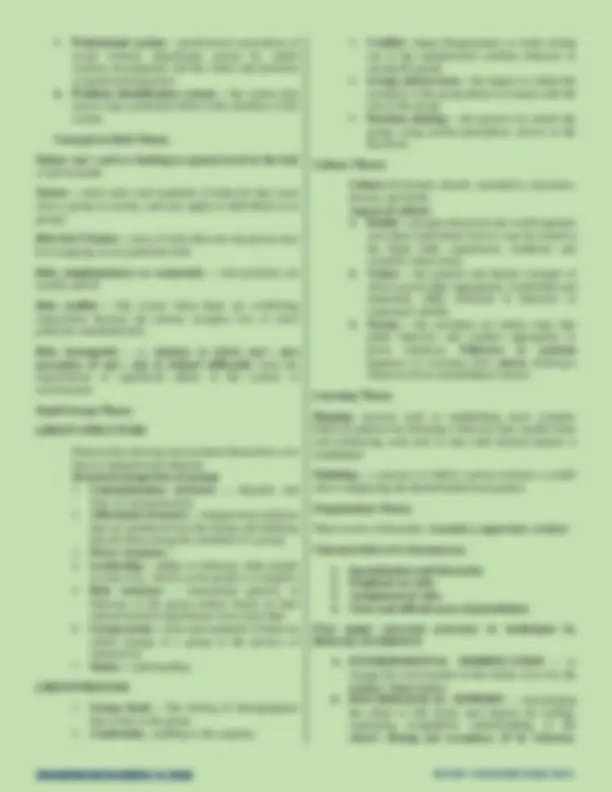
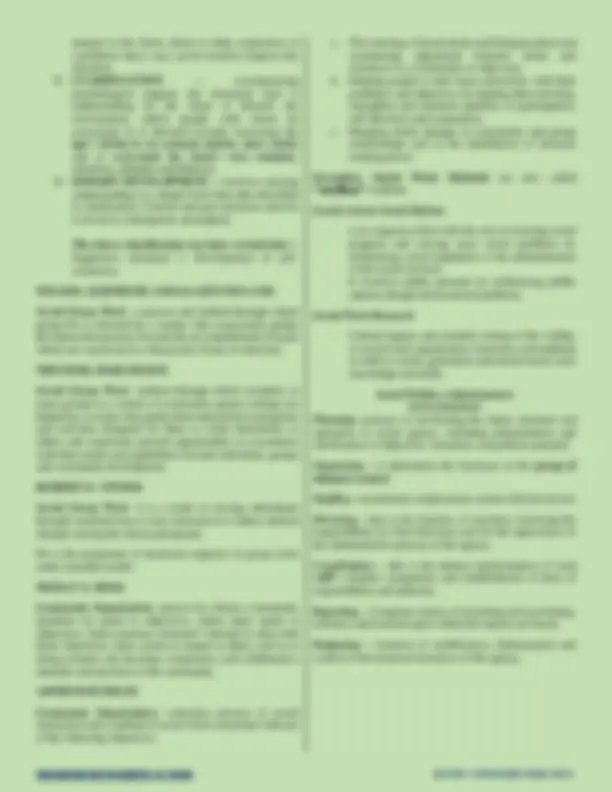



Study with the several resources on Docsity

Earn points by helping other students or get them with a premium plan


Prepare for your exams
Study with the several resources on Docsity

Earn points to download
Earn points by helping other students or get them with a premium plan
Community
Ask the community for help and clear up your study doubts
Discover the best universities in your country according to Docsity users
Free resources
Download our free guides on studying techniques, anxiety management strategies, and thesis advice from Docsity tutors
summary of the orange for social work
Typology: Summaries
1 / 36

This page cannot be seen from the preview
Don't miss anything!





























Thelma Lee Mendoza Published by: Central Book Supply Inc.
Chapter One
SOCIAL WELFARE An organized system of social services and institutions, designed to aid individuals and groups to attain satisfying standards of life and health, and personal and social relationship which permit them to develop their full capacities and to promote their well- being. (FRIEDLANDER)
Includes those laws, programs, benefits and services which assure or strengthen provision for meeting social needs recognized as basic to the well-being of the population (Elizabeth Wickenden)
Includes all those forms of social interventions that have a primary and direct concern with promoting both the well- being of the individual and the society as a whole. It includes the treatment and prevention of social problems, the development of human resources, and the improvement of the quality of life (Romanyshyn)
“An organized concern of all people for all people” (Gertrude Wilson)
It encompasses the well-being of all members of the society including physical, mental, emotional, social, economic and spiritual being.
Society responds to unmet needs through the following:
situation of stress, interpersonal helping or helping people in need.
SOCIAL SERVICES
Refers to the programs, services and other activities provided under various auspices, to concretely answer the needs and problems of the members of the society.
Concrete demonstration of social welfare or concern for the well-being of human society.
According to Richard M. Titmus, social problems are basically located in the economy. He considers social services as partial compensation for the “SOCIALLY GENERATED DISSERVICES AND SOCIALLY CAUSED DISWELFARE”
THREE GOALS OF SOCIAL WELFARE:
SOCIAL WORK
A profession which is concerned with man’s adjustment in his environment; a person in relation to a person’s social situation.
Social work seeks to enhance the social functioning of individuals, singly, and in groups, by activities focused upon their social relationship which constitute the interaction between man and his environment. These activities can be grouped into three functions: (^1) restoration of impaired capacity 2 provision of individual and social resources 3 prevention of social dysfunction
(US Council on SW Education)
Social Work in its various forms addresses the multiple complex transactions between people and their environment. (IASSW and IFSW)
PRINCIPLES OF HUMAN RIGHTS and SOCIAL JUSTICE are fundamental to social work
Chapter Two
THE PRE-HISTORIC PERIOD Social Welfare work in those times centered on mutual protection and economic survival. THE SPANISH PERIOD During the Spanish Period the Spaniards brought the teaching “to do good to others for the salvation of their souls” 1565 – Don Miguel Lopez de Legazpi established the first hospital in Cebu. 1882 – Hospicio de San Jose was founded to house the aged and the orphans. 1885 – Asilo de San Vicente de Paul, an asylum for girls was established The American Period 1899 – American introduced the new educational system, new health methods and religious freedom. 1900 – Phil. Normal School 1902 – Insular Board 1905 – American Red Cross, Philippine Chapter 1907 – La Gota de Leche 1910 – Phil. Anti – TB Society 1913 – Associacion de Damas Filipinas February 5, 1915 – PWB ( Public Welfare Board) January 1917 - Associated Charities of Manila 1921 – Office of Public welfare Commissioner 1922 - Office of Public welfare Commissioner prepared solicitation forms 1924 – Associated Charities became independent agency 1933 - Scholarship grants for professional training for Social Work Josefa Jara Martinez She worked on the Public Welfare Board and introduced the scientific approach in Social Work. Commonwealth Period
1940 – Department of Health and Public Assistance Service took over the activities that used to be performed by the Associated Charities before it had ceased to exist. Japanese Occupation Social Welfare activities during this period consisted mainly of giving medical care and treatment, as well as food and clothing, to the wounded soldiers, prisoners and civilians. Prominent among volunteer organizations are Philippine Red cross, Young Women’s Christian Association, and National Federation of Women’s League. The Post War Year 1946 – Bureau of Public Welfare re- opened. 1946 – UNICEF was created. October 4, 1947 – the Bureau of Public Welfare became the Social Welfare Commission and was placed under the Office of the President. August 1948 – PACSA was created by Pres. Quirino. 1948 – UNICEF became active in the Phil. January 3, 1951 – SWC and PACSA was fused in only one agency which is Social Welfare Administration. The Seventies Sept. 8, 1976 – Department of Social Welfare became the Department of Social Services and Development. June 2, 1978 – Ministry of Social services and Development. The Eighties
R.A 5416 1968 Empowers the Department to:
DSWD VISION “a society where the poor, vulnerable and disadvantaged individuals , families, and communities are empowered for an improve quality of life”
DSWD MISSION
The agency offers both local as well as overseas programs and services for Filipino contract workers and their dependents in keeping with the provisions of the Labor Code.
National Housing Authority (NHA) Created under Presidential Decree No. 757 in 1975. It’s mandate is to develop and implement a comprehensive and integrated housing program in the country. Focused in providing housing assistance to the lower 30% of the urban population. The NHA also provides technical and other forms of assistance to local government units in implementing their urban development and social housing programs.
Public Attorney’s Office (PAO) Under the DOJ and used to be known as the Citizen’s Legal Assistance Office (CLAO). It represents, free of charge, indigent persons or the immediate members of their families, in all civil , administrative, and criminal cases where, after due investigation, and the interest of justice will be served.
Some Private Social Welfare Agencies and Organizations Philippine Business for Social Progress (PBSP) A private, non-profit organization established on December 16,1970, to serve as private enterprises’ implementing arm for social development. Its current priorities are indigenous peoples, small lowland farmers, small upland farmers, sustenance fisher folks, landless rural workers, and the urban poor.
SOS Children’s Village A private child caring agency founded by Dr. Hermann Gmeiner in Austria after World War II. Outside of adoption, it is the only agency which implements Alternative Parental Care formulating a purposely planned long-term care orphaned and abandoned Filipino children.
Women’s Crisis Center (WCC) This agency was established to pursue the following goals: Establishment of holistic feminist services for victims/ survivors of all forms of violence against women.
Elimination of all forms of violence against women through the formation of women’s communities, supporting initiatives and encouraging partnership. Change and transformation of existing values and attitudes that breed violence against women through the application of feminist principles. MAJOR PROGRAMS: o Crisis Intervention o Feminist Counseling (face-to-face and hotline) o medical assistance and advocacy o legal assistance and advocacy o temporary shelter o survivor’s support group o education and advocacy o training and education o research o documentation and publication o consultancy services
HAVEN, a hospital-based crisis center for women survivors of a violent environment and also coordinates with NGOs all over the country in efforts to prevent and eliminate family violence.
Center for the Prevention and Treatment of Child Sexual Abuse (CPTCSA) Established to help children, and their families, who are victims of sexual abuse. It offers them protective services, prevention and treatment services, training, research and advocacy, post-rehabilitation, educational and medical assistance, housing, legal assistance, and technical training.
Tribal Development Foundation in the Philippines This agency addresses the needs of tribal communities in different parts of the country. Its services include: skills development and livelihood projects, tribal leadership training, educational assistance and adult literacy.
Associated Charities
THE PHILIPPINE ASSOCIATION OF SOCIAL WORERS – PASWI
Chapter Three SOCIAL FUNCTIONING: SOCIAL WORK’S FOCUS OF CONCERN
Wernes Boehm
impetus towards health, growth and belonging, and organized efforts of society to integrate its parts into a productive and dynamic whole.
William Gordon
Social Role – socially recognized pattern of behaviors and activities expected from an individual occupying a certain position in society.
THREE WAYS OF SOCIAL WORKERS TO IMPROVE SOCIAL FUNCTIONING OF INDIVIDUAL
THE FUNCTIONS OF SOCIAL WORK
DOMINANT VALUES OF FILIPINO
1. SOCIAL ACCEPTANCE – defines as being taken by one’s fellows for what one is, or believes he is and being treated in accordance with his status. a. Smooth Interpersonal Relation S.I.R 1. Pakikisama which means giving in concession or following the lead of suggestion of another. 2. Euphemism means stating of an unpleasant truth, opinion, or request as pleasantly as possible. 3. Go Between or tulay means 3rd party who will carry a message b. Amor Propio is a term used to refer to the sensitivity to personal affront and functions to protect the individual against loss of social acceptance. Hiya is fear of exposure of one’s insecure self. 2. Emotional Closeness and Security in a Family
Seven Principles of the Social Work Relationship Felix Biestek PURPOSEFUL EXPRESSION OF FEELINGS
PASWI CODE OF ETHICS
A. Relative to Self and the Profession
To conduct myself in a manner consistent with the philosophy, principles, values and beliefs of the social work profession.
To act at all times with honesty, openness and transparency in all my professional transactions.
To constantly work towards my own professional advancement so as to contribute to the promotion of social work practice
To contribute time and professional expertise to activities that promotes respects for the integrity and competence of social workers.
To contribute time and professional practice wisdom to colleagues and other professionals
To be vigilant and act to prevent the unauthorized and unqualified practice of social work.
To support the professional association duly organizes and constituted for the professional welfare of all social workers
To respond and volunteer my professional services in times of emergency.
To uphold and protect the dignity and integrity of the profession
To promote cultural values that will enhance the practice of the social work profession
obligation and constraining...” “…All social life seems to me based on genuine morality, whose core is obligation, and whose condition for existence is choice, and so freedom to choose.”
INTRODUCTION TO SOCIAL WORK PRACTICE 1967 National Workshop on social Work Education resulted to: o Dictated that schools teach social work methods based on generics approach o Develop skills based on generic aspects of the methods used by social worker Integrated method of Social Work Practice US = Generalist Social Approach PH Against the separation of Methods (Casework, Group Work, Community Organization): Herbert Bisno, Comptom and Galaway Herbert Bisno – the inclusion of a quantitative attribute of the potential transaction unit in the designation of the method has led to an illicit bond between a given method and a given, but arbitrary restricted and limiting client system. Bisno’s 9 Social work method
o Process PROCESS PLANNED CHANGE- a change originating from decision to make a deliberate effort to improve the system and to obtain the help of an outside agent in making this improvement. Client System (CS)- System that is being helped Outside Agent- professional Agent Problem- or situation assessed is the reason of entry of the change agent Process- or the development of the helping relationship. It consists 7 phases. Change Force- increases the willingness of the CS for change Resistance Force-reduces the willingness of CS for change
Chapter Five
Alfred Kadushin
OUTLINE OF THE SPECIFIC KNOWLEDGE REQUIRED FOR THIS AREA FRAMEWORK
Chapter Six THE ESSENTIAL ELEMENTS IN SOCIAL WORK PRACTICE
PHASES OF PLANNED CHANGE
PHASE 1: client system discovers the need for help PHASE 2: helping relationship is established and define PHASE 3: problem is identified and clarified PHASE 4: change goals/ intention is established PHASE 5: change effort is attempted PHASE 6: change is generalized ad stabilized PHASE 7: H-R ends
DYNAMICS OF PLANNED CHANGE Change Force- aspect of the situation which increases the willingness of the c-s to make a propose change Resistance Force- aspect of the situation which reduces the willingness of the client system to change
Chapter Seven
c. Strive to evaluate herself and her on values by looking at the origin d. Strive to change those values that need to be changed
2. AUTHORITY/PROFESSIONAL AUTHORITY/POWER Position or functions in the agency; and professional knowledge and experience 3. COMMITMENT AND OBLIGATION Accountability and responsibility to Clients and others Naomi I. Brill – recognizing the worker’s value system defines her behavior and relationships with other people, believes that the effective worker must:
AUTHORITY (and the power that accompanies it) 0 there are 2 sources of a worker’s authority – her position and corresponding functions in the agency, and her possession of knowledge and experience. o GODSTEIN points out that is SW relationships, when one seeks something from another person “that cannot be obtained elsewhere – the relationship cannot be equalized.
COMMITMENT AND OBLIGATION – to bind or pledge one’s self to relationship; to obligate one’s self is to perform the moral responsibility that goes with a pledge or a promise made
HELPING CONTRACT is frequently used in reference to the expectations and terms of the commitments and obligations of both client and worker, which are often clearly spelled out.
STEPS IN SOCIAL WORK HELPING PROCESS Assessment Max Siporin – assessment is a process and product of understanding on which action is based. The process involves the collection of necessary information and analysis and interpretation in order to reach an understanding of the client, the problem, and the social context in which it exist.
ASSESSMENT o Also termed as diagnosis and social study o Involves the collection of necessary information and its analysis and interpretation o The ultimate purpose is to provide understanding necessary for appropriate planning.
o The major tasks involved during this stage are data, gathering, and problem definition based on the agreement between the client and the worker as to the problem-for-work. o These tasks culminate in the worker’s writing of an Assessment Statement or a Problem Definition. o TYPES OF SOURCES
**1. Primary source – the client
In working in a small group, a worker does individual or group intake interviews.
Individual Intake Form : community identifying information, presenting problem and circumstances relating
to this, background data and other pertinent information obtained during the initial contact with the community.
DEFINING THE PROBLEM Compton and Galaway - the way you define the problem will define the data collected and will dictate what are seen as appropriate answers. Problem for work- place of beginning together which means problem or part of the problem that:
Defining the problem – the problem for work means:
WRITING AN ASSESSMENT STATEMENT
Components of an assessment statement by Maria O’niel Mcmahon: Opening casual statement- this requires the worker to clearly indicate who’s has the problem, and why the problem exists at the time. Change potential statement- a statement- a problem’s change potential is dependent on three interdependent factors: problem, person and environment. Judgment- about the seriousness or urgency of the problem.
CHARACTERISTICS OF ASSESSMENT
PLANNING
The link between assessment and intervention Planning process translates the content of assessment into a goal statement that describes the desired results and is also concerned with identifying the means to reach the goals. 2 majors task during the planning stage:
PLANS Means to achieve goals Consist of the specific actions/steps to be undertaken in order to reach the goals. Jointly made by the worker and the client, helping Plan, Action Plan, or intervention Plan Systematic review of the client strengths when preparing of intervention plan is one way to avoid offering an intervention plan without considering alternatives with the client.
UNITS OF ATTENTION Intervention or Action/Helping Plan calls for an identification of other persons who, in additions to client, have to be given attention because they are involved in the situation, and work with them is essentials to goal attainment Systems that are the focus of the change activity.
STRATEGY DEFINED AS AN OVERALL APPROACH TO CHANGE A SITUATION
Factors that influence the plan of action
The assessment and planning steps in the problem solving process culminates in the workers writing of a case study that contains the synthesis of the information that has been obtained on the client and his situation, and assessment
Summative evaluation concerned with outcomes of effectiveness Formative evaluation concerned with looking at the process of the work. It forces the worker to find out whether the implementation plan is being implemented as designed o Intervention plans can be viewed in 2 levels conceptual level and operational level. Professional accountability - SWer and SW agencies must answer for their work, not just to client who are the direct users, but to the public that supports them. 2 Aspects of Accountability o Effectiveness - refers to the questions on whether or not the services or intervention plans are accomplishing their intended goals; o Efficiency - refers to the cost of services and intervention plans in money, time and other resources.
TERMINATION
MOST COMMON REASON FOR TERMINATING CLIENT WORKER RELATIONSHIP
TRANSFER – process by which the client is referred by his social worker to another worker usually in the same agency because the former will no longer be able to continue working with the client… REFERRAL – an act directing a client to another worker/agency because the service that the client needs beyond the present agency worker’s competence, or the
client needs additional services which the present agency cannot provide.
COMPONENTS OF TERMINATION according to Pincus and Minahan
A. DISENGAGENMENT
Most Common Reactions during termination/disengagement
1. Denial – avoid painful feelings. Avoiding the discussion of termination. 2. Emotional reaction – fear of loss or fear of the unknown can give rise to the feeling of sadness and grief. There can be anger expressed in verbal outburst of physically violent behavior directed towards the worker or other significant others.
B. STABILIZATION OF CHANGE
Ronald Lippit – contend that the main test of a change agent’s help is the stability and performance of the client system’s changed behavior when the change agent is no longer actively working with client. They submit “ the change process must equip the client system to carry on effectively in a wide range of day to day activities after the initial change project is over” Robert Vinter – explains this as the requirement of transferability. i.e gains achieved by the client within the helping process must be transferrable beyond this process, and the degree of improvement should be assessed according to conventional standards in the community.
C. EVALUATION It is ongoing part of helping process. Periodic/regular evaluation allows the worker and the client to review and, if necessary, revise the goals and objectives …..
Spin- offs or unexpected/unwanted consequences
Chapter Eight SOCIAL WORK HELPING MODELS AND APPROACHES
I. For individual, groups and communities: direct provision model, intercession- mediation model, mobilizing resources of clients system to change their realities, crisis intervention approach and problem solving model II. For individual and groups: task-centered model, psychosocial approach, functional approach, behavioral modification, and family intervention III. For groups: developmental approach, interactionist approach, remedial approach IV. For communities: community development model, social planning model, social action model V. Indirect model of intervention : working with the elite, documentation/social criticism, advocacy
Involves the direct administration of existing programs of material aid. This should not be equated with dole out. Other refers to this as Resource Provision, where resources may be mobilized, created, directly furnished where the client may be advised and counseled in making optimal use of them.
Proponents and principles/Key Concepts Schniederman: the goal of this model is the enhancement of client social functioning through the direct functioning through the direct provision of material and useful in eliminating or reducing situational deficiencies.
Helping Process : APIET Activities:
Recruiting, selecting, training, supporting, collaborating with personnel offering direct care (e.g. Homemakers, foster parents, adoptive parents, health personnel, trainers, day care workers)
Example: A family who’s want to take advantage of the government’s Balik Probinsya Program
Involves the process of negotiating the service jungle for clients, whether singly or in groups. The worker connects the client to need services in the system until he has availed of them Social Worker takes partisan interest in the client and his cause. Advocacy efforts of the social worker are frequently directed towards securing benefits to which the client is legally entitled.
Proponents and principles/Key Concepts Schneiderman : the utilization of non-consensual strategies such as direct confrontation, administrative appeal, and the use of judicial and political systems, as an appropriate
Helping Process: APIET Activities: Social Workers may need to argue debate, bargain, negotiate and manipulative the environment on behalf of the client.
Example: Working women are defined labor benefits by their employers, juvenile offenders who are arrested, the illegal detained, neglected prisoners who should already qualify for parole privileges, slum dwellers who are having illegally evicted.
is a Process for actively influencing the psycho-social functioning of individuals and groups, during the period of acute disequilibrium. Involves crisis-oriented, time limited work, usually 2 or 6 weeks in duration. To be really effective, it should be available within 24 to 72 hours after application or referral for assistance.
Key Concepts Crisis is defined as an upset in a state, an emotional reaction on the part of an individual, family or group to a threatening life event.
The theory is based on the idea that there is no such thing as a problem-free state and life is a series of recurring development crisis.
Lydia Rapoport Goals for this approach: Relief of symptoms Restoration to the optimal pre-crisis level of functioning Understanding of the relevant precipitating events that contribute to state of disequilibrium Identification of remedial measures that can be taken by the client and the family Recognition of the connection between the current stress and past life experiences and conflicts
A technology for alleviating specific target problems perceived by clients, that is, particular problems clients recognize, understand, acknowledge and want to attend to. A task is what the client is to do to alleviate the problem, which makes the task both an immediate goal, and at the same time the means of achieving the goal alleviating the problem.
Laura Epstein, Professor Emeritus and William Reid.
This model is
Features of the model:
THE PROCESS: Start up: clients referred by an agency or client applies independently and voluntarily
Step 1: Client Target problems identified Step 2: Contract, plans, target problem priorities, goals, practitioner tasks, duration, schedule, participants Step 3. Problem Solving Step 4: Termination
TASK CENTERED MODEL WITH GROUPS
Preliminary interview – problems are explored, clarified elicited in individual interviews
Group Composition - SW decides who should be in a particular group, and the size of the group.
Group Formation - The members share the problems that they will seek to reduce or eliminate by formulating and accomplishing agreed-on tasks
Group processes for task accomplishments - SW works with the group so they can help each other to accomplish the tasks within the time frame agreed upon.
Example: Client who lacks the motivation and interest in continuing his studies.
Referred to organismic approach and diagnostic school of thought
A systems theory approach concerned both the inner realities of human beings and the social context in which they live.
The person being helped is seen in the context of interactions or transaction in the internal worlds and effort are taken to understand the segment of the external world with which the person is in the close interaction.
Treatment is differentiated according to the client’s needs, hence the term differential treatment.
The worker must engage in fact-gathering and come with a professional opinion called diagnosis or assessment. The help provided in this approach will enable change to occur in the person or in the situation or both.
Key concepts/ proponents Mary Richmond, Marion Kenworthy, Bersey Libbey, Gordon Hamilton, Lucille Austin and Florence Hollis
6 Procedures of Intervention (Hollis)
The process:
Initial phase : understanding the reasons for contract, establishing, engaging the client in the treatment, beginning treatment itself (treatment begins in the first interview) psychosocial study (gathering the information needed for the psychological diagnosis and guidance of the treatment)
Assessment of the client in His Situation; consists of a critical scrutiny of a client-situation complex and the trouble concerning which help is sought or needed.
3 TYPES OF DIAGNOSIS Dynamic: Examination aspects of the client’s personality interact to produce his total functioning, interplay between the client and other systems, dynamics of family interaction.
Etiology the cause or origin of the difficulty usually multiple factors in the person-situation configuration Classificatory: classifies various aspects of the clients functioning and his place in the world including, if possible, a clinical diagnosis (refers to classify based on personality disturbance) classifying individuals according to socio economic class, race, ethnic background and religion.
Treatment Indirect treatment: the worker intervenes directly in the environment of their client by obtaining needed resources and modifying the client’s situation when change in his situation is necessary Direct treatment involves direct work with the client himself or what Hollis describes as the influence of mind upon mind
An approach intended to improve the social functioning of individuals, families, groups and organizations by helping them learn new behaviors and eliminating problematic ways of behaving.
Usually used in group work to shape stabilize, modify, or alter clients’s behavior with the use of certain techniques such as reassurance, reinforcement etc.
Proponents :
Wilheim Wundt, John Watson, Ivan Pavlov, Clark Hull, Edward Tolman, B.F. Skinner, Joseph Wolpe, Albert Bandura and Hans Eysenck
Decisions that guide the change process are made on the basis of data, not on the basis of assumption about why people behave as they do.
The process:
Focus •Upon observable responses •More on the fundamentally classes of behavior: Emphasizes Observation, data collection and careful measurement before, during and after the intervention
Three elements of social learning
1. Target behavior - behavior that will be the focus of intervention 2. Antecedent behavior – the behavior that occur prior from the **problem behavior
BEHAVIORAL TECHNIQUES
1. Conditioning a. Classical conditioning – learning of a behavior because it is associated in time with specific stimulus with which it was formerly associated. b. Operant conditioning – learned behavior which takes place because it operates upon or affects which takes place because it operates upon of affects environment
SOCIAL WORK ROLES:
Direct Modifier – the worker is the agent of modification in which she herself directly uses a technique like positive reinforcement to increase a child behavior relating to observing rules.
Behavioral Instigator – the worker influences a situation so that behavior will be modified such as introducing a point of rewards system to encourage task performance in youth home.
Teacher – the worker teaches behavioral modification techniques to clients, parents, related professional, and other professionals.
a method for engaging the client through relationship essentially one to one in the use of a social service toward his her own and the general social welfare.
The purpose of the service being offered helps to give sharpness and focus to the diagnosis or the understanding needed for the particular pathological condition for which a type of treatment is defined in order to achieve an environment goal. Agency service is made available Key concepts/ proponents